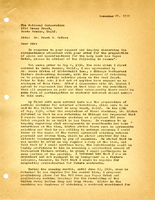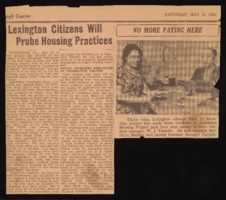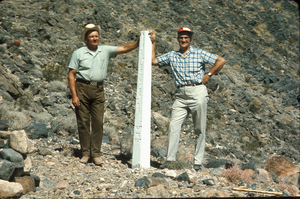Search the Special Collections and Archives Portal
Search Results

Letter from Homer Rissman to Frank S. Hofues, Santa Monica, December 21, 1955
Date
Archival Collection
Description
Five-page letter from Homer Rissman to Frank Hofues regarding the Lady Luck Casino, later named the Hacienda.
Text

Housing Authority of Williamson, West Virginia: scrapbook, work notes, correspondence, and newspaper clippings
Date
Archival Collection
Description
Folder of materials from the Mabel Hoggard Papers (MS-00565) -- Civic engagement file. Includes a scrapbook, work notes, correspondence, and newspaper clippings related to Mabel Hoggard's employment at the Housing Authority of Williamson, West Virginia.
Mixed Content

Letter and envelope from Annie Ronnow, Provo, Utah. to Mary Etta Syphus, Panaca, Nevada
Date
Archival Collection
Description
From the Syphus-Bunker Papers (MS-00169). The folder contains an original handwritten letter, an envelope, a typed transcription of the same letter, and a copy of original letter attached.
Text

Slide of John Lytle at Emigrant (Fremont) Gap on the Old Spanish Trail, California, circa 1960s
Date
Archival Collection
Description
Image

Chart showing construction data of Las Vegas Land and Water Company wells, circa 1944
Date
Archival Collection
Description
List of the Las Vegas Land and Water Company wells with details regarding each.
Text

Memo from A.W.F. to Walter R. Bracken in response to C. R. Gray's letter about the Stewart Ranch property, August 1, 1929
Date
Archival Collection
Description
One particular part of the lands purchased from Helen Stewart was apparently for right of way and terminal facilities since it does not have any water rights associated with it.
Text

Letter from A. M. Folger (Las Vegas) to William Reinhardt, August 17, 1948
Date
Archival Collection
Description
Discussion of details regarding the drilling of a well on the Las Vegas Ranch.
Text

Letter from A. M. Folger (Las Vegas) to Frank Strong, June 7, 1948
Date
Archival Collection
Description
The charges for water for the hospital seemed to be too high and Folger was asking for permission to lower them.
Text


